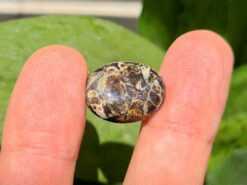Pyrite

Buy natural gemstones in our shop
Gold of fools
The term pyrite is attributed to dioscorides in the year 50. it was noticed by the ancients for the sparks which it produces under shocks. The term comes from the Greek πυρίτης (λίθος) – pyrítēs (líthos) – literally “fire stone”.
There are many synonyms for this species:
- Sulphurated iron (Haüy)
- Hepatopyrite.
- Fools gold (common term with chalcopyrite). During the gold rush, the ignorance and despair of many miners led them to confuse the stone with chalcopyrite with gold because of their brilliance and color. Paradoxically, contains traces of gold (arsenic and gold are elements that enter the structure via coupled substitution), the precious metal prospected in the sediments resulting in particular from the diffusion of its element Chemical out of the mineral for millions of years.
- Pyrit (Haidenger)
- Schwefelkies (Werner).
- Sideropyrite.
- Tombazite.
- Xanthopyrite.
From the macroscopic point of view, crystals often take dodecahedral forms with pentagonal faces called pyritohedrons. Generally, it forms crystals of cubic, octahedral or pyritohedral habit, the faces of which can be striated.
The metallic shine is bright and opaque and the color is pale golden. Its line is green-black to brown and gives off a smell of sulfur.
Its hardness is between 6 and 6.5 on the Mohs scale. Its fracture is irregular and sometimes conchoidal.
The stone is weakly soluble in nitric acid. It becomes magnetic when heated. When merging between 177 ° C and 1188 ° C, it forms a magnetic pellet.
Iron pyrite is unstable in the natural environment: in nature it is always being created or being destroyed. exposed to air and water decomposes into iron oxides and sulfate.
This process is hastened by the action of Acidithiobacillus bacteria which oxidize the crystal to produce ferrous iron and sulfate. These reactions occur more rapidly when the stone is in fine crystals and dust, which is the form it takes in most mining operations.
Crystal pyrite meaning and properties
The following section is pseudo scientific and based on cultural beliefs.
Fool’s gold has long been valued as a strong protection stone that shields the wearer from negative energy as well as environmental pollutants. Thus, this stone helps promote physical well-being as well. Stimulating the second and third chakras, The stone enhances strength of mind and willpower.
Sample from Stung Treng, Cambodia
FAQ
What are the benefits of pyrite?
the crystal is a powerful protection stone which shields and protects against all forms of negative vibrations and/or energy, working on the physical, etheric, and emotional levels. It stimulates the intellect and enhances memory, helping to recall relevant information when needed.
Does pyrite stones attract money?
The stone is one of the best feng shui stones for attracting the energy of wealth and abundance, another popular crystal for wealth is citrine. You can also place the crystal in your own lucky direction for money.
What does Fool’s gold symbolize?
It reflects the energy of gold, bringing success, enthusiasm, happiness, and power. It is traditionally the color of kings, riches, and the sun.
Is pyrite dangerous to wear?
The stone is included on lists of toxic minerals because it might contain small amounts of arsenic. Yes, It can contain some arsenic, but since the crystal is not soluble in water or hydrochloric acid it poses no risks when handled.
Does pyrite bring good luck?
Fool’s gold is probably most well-known for bringing good luck and prosperity. The vibration of this crystal is high, yet extremely grounding. A bringer of abundance. Also greatly enhances the energy of any space.
Is gold fools worth anything?
Fool’s gold received that nickname because it is worth virtually nothing, but has an appearance that “fools” people into believing that it is gold.
















